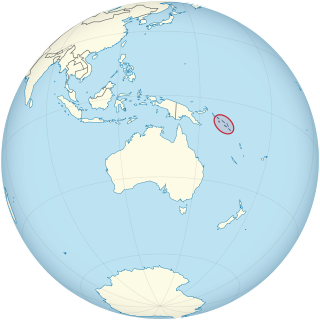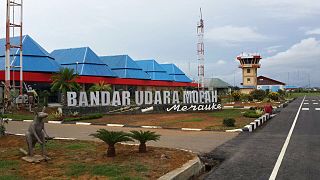
Mopah International Airport is an international airport in Merauke, South Papua, Indonesia. The airport is Indonesia's second easternmost airport after Sentani International Airport in Sentani. The airport serves as the main gateway to several tourist destinations around Merauke, the most notably is Wasur National Park.
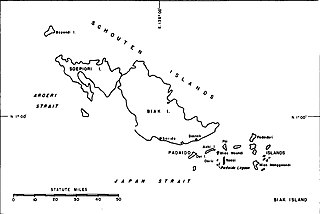
Mios Woendi island is an island in the Schouten Islands of Papua province, eastern Indonesia. It lies in Cenderawasih Bay 50 kilometres off the northwestern coast of the island nation of Papua New Guinea.
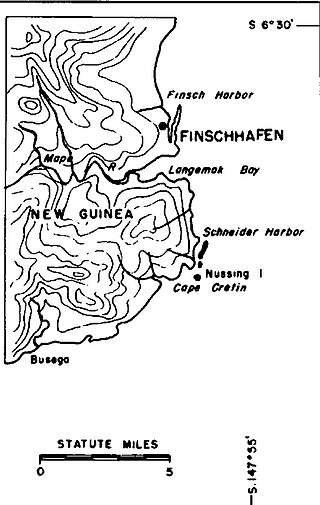
Dreger Harbour is a harbour south of Finschhafen, Papua New Guinea.

US Naval Advance Bases were built globally by the United States Navy during World War II to support and project U.S. naval operations worldwide. A few were built on Allied soil, but most were captured enemy facilities or completely new. Advance bases provided the fleet with support to keep ships tactically available with repair and supply depots of facilities, rather than return them to the continental United States. Before Japan declared war on the United States the U.S. Navy had a single fleet-sized advanced base in the Territory of Hawaii at Naval Station Pearl Harbor. During the war the U.S. Navy Seabees built over 400 advance bases categorized by size. Naval bases were either Lions or Cubs while airfields were either Oaks or Acorns. Lions and Oaks were major facilities while Cubs and Acorns were minor. PT Boats typically would get a Cub and airfields with single runways were Acorns. The larger bases could do refueling and overhaul; loading of troopship and cargo ships; and preparing amphibious assault ships. Some became major repair depots. The Seabees developed auxiliary floating drydocks were able to repair battle damage and do regular maintenance in the field saving ships trans-pacific trips for repair. A few bases also were developed to be R and R for all U.S. personnel. Most Advance Bases were built by the US Navy's Seabees in Naval Construction Battalions (CBs). At the start of the war civilian contractors were employed in construction. The Seabees in World War II built most of the airfields used by the United States Army Air Forces and United States Marine Corps, as they had the ships and cranes needed to transport the vast amount of equipment needed at the advance bases. The US Army and United States Coast Guard also operated out of many of these facilities. Seabees could build new or repair damaged runways, and with advancements in heavy bomber technology lengthen runways as needed. A few Naval Advance Bases were built for the Korean War and Vietnam War.

Naval Base Milne Bay, also called Naval Advance Base Milne Bay, was new major United States Navy sea and airbase base built on Milne Bay in Milne Bay Province in south-eastern Papua New Guinea. By spring 1943, the build up of the US Navy to support the Pacific War had caused overcrowding at the ports on the east coast of Australia. To help, Seabees departed Naval Base Brisbane on June 19, 1943 to set up a new base in Milne Bay. Naval Base Milne Bay headquarters was at Ladava Navy Base. The Royal Australian Navy already had a small base in Milne Bay: HMAS Ladava. Australians were able to defend and keep Milne Bay in the Battle of Milne Bay in 1942. Naval Base Milne Bay was built during World War II to support the many ships and aircraft fighting and patrolling in the South West Pacific theatre of war. Ladava Navy Base provided a large protective US Navy fleet anchorage at Gahora Bay next to Ladava. At Naval Base Milne Bay, Seabees built a large Naval facility.

Naval Base Manila, Naval Air Base Manila was a major United States Navy base south of the City of Manila, on Luzon Island in the Philippines. Some of the bases dates back to 1898, the end of the Spanish–American War. Starting in 1938 civilian contractors were used to build new facilities in Manila to prepare for World War II. Work stopped on December 23, 1941, when Manila was declared not defendable against the Empire of Japan southward advance, which took over the city on January 2, 1942, after the US declared it an open city. US Navy construction and repair started in March 1945 with the taking of Manila in the costly Battle of Manila ending on March 2, 1945. Naval Base Manila supported the Pacific War and remained a major US Naval Advance Base until its closure in 1971.

Manus Naval Base was a number of bases built after the World War II Battle of Manus by United States Navy on the Manus Island and a smaller island just east, Los Negros Island in the Admiralty Islands chain. The major naval base construction started with the Los Negros landings on February 28, 1944. The Navy repaired and did the expansion of the airfields on the Admiralty Islands. United States Navy Seabee built or repaired the facilities on the islands. The large Manus Naval Base, also called the Admiralty Island base, supported United States Seventh Fleet, Southwest Pacific command, and part of the Pacific Fleet. The base was abandoned by the US Navy after the war.

Naval Base Brisbane was a major United States Navy base built in the early part of World War II at Brisbane, Queensland, Australia. At first, operated as a base for patrol aircraft and convoy escort aircraft to protect the last leg of the Pacific War to the Southwest Pacific. As the US Navy expanded in the island hopping campaign, Naval Base Brisbane expanded to include a submarine base, repair depot, seaplane base and other facilities. US Navy operations started on April 14, 1942, and ended after the war in 1945.

Naval Base Darwin was a United States Navy base built during World War II at Darwin, Northern Territory, Australia. The first US operations at Darwin was Naval mine depot, built to supply Australia with mines to support the Pacific War. As the US Navy expanded in the Island hopping campaign, Naval Base Darwin expanded to include a Port Darwin submarine base, PT boat Bases, and other facilities. US Navy operations started in 1942 and ended after the war in 1945.
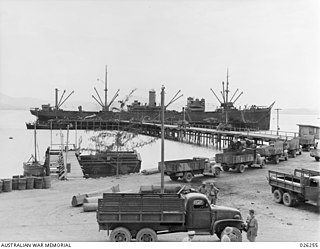
Naval Base Port Moresby was a United States Navy base built during World War II at the city of Port Moresby on Papua New Guinea. The US Navy built a communication center and advance base headquarters for the US Seventh Fleet to support the Pacific War in 1943. The base was part of the New Guinea campaign.

Naval Base Woodlark Island was a United States Navy base built during World War II on Woodlark Island on Papua New Guinea. The US Navy built a PT boat base, boat repair depot, and harbor facilities at the city of Guasopa to support the Pacific War in 1943. The Harbor facilities was also built to support the US Navy in building the Narewa Airfield on the island. The base was part of the New Guinea campaign.

Naval Base Finschhafen was a United States Navy base built during World War II at Finschhafen on the Huon Peninsula in Morobe Province of Papua New Guinea. The US Navy built a PT boat base, Dreger Harbor PT Boat Base, boat repair depot, and harbor facilities at Dreger Harbour and Langemak Bay to support the Pacific War in 1943. Harbor was also built to support the US Navy in building 6,000-foot Finschafen Airfield, also called Dreger Field, now Finschhafen Airport on the island. The base was part of the New Guinea campaign.

Naval Base Hollandia was a United States Navy base built during World War II at Humboldt Bay, near the city of Hollandia in New Guinea. The base was built by the US Navy Seabees during the Battle of Hollandia, starting on May 9, 1944. Later Naval Base Hollandia became a supply base to support the invasion of the Philippines that started on October 20, 1944. Naval Base Hollandia became an advance headquarter of the United States Seventh Fleet.

Naval Base Alexishafen was a United States Navy base built during World War II at Alexishafen, north of the city of Madang in New Guinea. The base was built by the US Navy Seabees starting June 13, 1944 as part of the New Guinea campaign of the Pacific War. The base was built at the request of the Seventh Amphibious Force of the United States Seventh Fleet to support the many boats patrolling the area. The US Navy built a boat repair depot including Auxiliary floating drydocks. The base was closed in January 28, 1945.

Naval Base Banika Island was a United States Navy base built during World War II on Mbanika Island in the Russell Islands, part of the Solomon Islands. A larger supply depot was built to support the ships fighting in the Pacific War. Also built were a repair base for landing craft, PT boats, and other boats. Banika Island offered excellent fleet anchorage. Banika Island was taken during the Solomon Islands campaign. Also at the base was built the Renard Sound Seaplane Base.

Naval Base Puerto Princesa, Naval Base Palawan, was a United States Navy base built during World War II at Puerto Princesa on Palawan Island, Philippines, after the Invasion of Palawan on February 28, 1945. Puerto Princesa Bay offered an excellent base for fleet anchorage. At the naval base, US Navy Seabees built: a seaplane base, carrier aircraft fighter plane repair depot, land airfield and other base facilities.
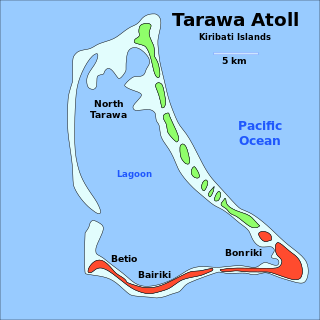
Naval Base Tarawa was a naval base built by the United States Navy in 1943 to support the World War II effort. The base was located on Tarawa atoll in the Gilbert Islands in the Central Pacific Ocean. The base was built as one of many advance bases in the island-hopping campaign towards the Empire of Japan. At Naval Base Tarawa the Navy built a seaport, seaplane base and two airbases. Construction started after the Battle of Tarawa ended November 23, 1943, part of Operation Galvanic.

Naval Base Abemama was a naval base built by the United States Navy in 1943 to support the World War II effort. The base was located on Abemama atoll, also called Hopper Atoll, in the Gilbert Islands in the Central Pacific Ocean. The base was built as one of many advance bases in the island-hopping campaign towards the Empire of Japan. At Naval Base Abemama the Navy built a seaport and airbase. Construction started after the Battle of Abemama ended November 24, 1943, part of Operation Galvanic.

US Naval Base New Guinea was number of United States Navy bases on the island of New Guinea during World War II. Australia entered World War II on 3 September 1939, being a self-governing nation within the British Empire. The United States formally entered the war on 7 December 1941, following the attack on Pearl Harbor by the Empire of Japan. Following the attack on Pearl Harbor, Japan quickly took over much of the South Pacific Ocean. The United States lost key naval bases in the South Pacific, including Naval Base Manila and Naval Base Subic Bay, both lost in the 1941–42 invasion of the Philippines. Also lost were Naval Base Guam and Wake Atoll. As such, the United States Armed Forces needed new bases in the South West Pacific for staging attacks on Japan's southern empire. The United States built bases first in Australia, then in New Guinea.

























